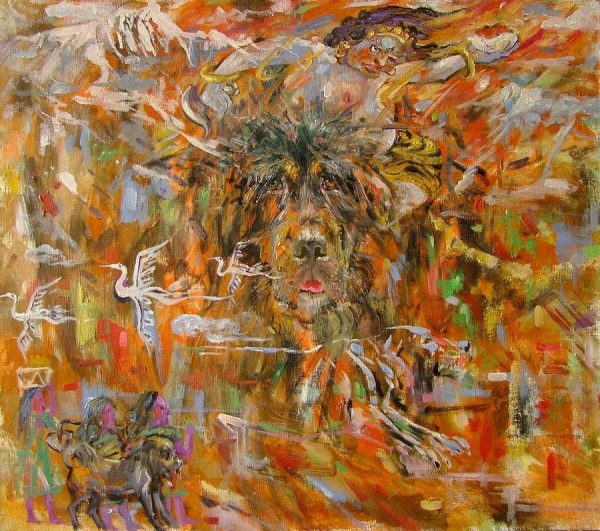
We confess a weakness for legends and folk tales surrounding purebred dogs, and surely the Tibetan Mastiff has more than its share of them.
As one bit of folklore goes, Tibet was covered in snow and ice when a deadly plague ran rampant throughout the land. A heavenly god came down from the heavens riding a Tibetan Mastiff, and thawed the ice and snow, bringing the land back to life and saving the people. At this point, we go all “sciency” on you. Bioarchaeological and phylogenetic studies identified Central Asia as an early reservoir for Yersinia pestis, the bacterium responsible for the bubonic plague between the seventh and ninth centuries. Official Tibetan histories tell of human and animal plagues at the turn of the eighth century, so it’s known that a devastating illness did befall Tibet. That said, scant evidence (as in none) supports the account that a Tibetan Mastiff rode down from the heavens with a god on its back, but one never knows. Perhaps the story started in the delirium of a feverishly ill person who recovered after seeing a Tibetan Mastiff. Certainly, the breed is one of, if not the oldest dog breed in the world, and is considered by many cynologists to be the basic stock from which most modern large working breeds have developed. We admit that it’s a fanciful bit of theorizing on our part about how this particular myth got its start, but that’s the interesting part of legends. Some of them often have just enough provable facts to make one wonder….
Another legend surrounding the breed is rooted in faith. Some believe Tibetan Mastiffs are the reincarnations of people who have not reached the next level of enlightenment, and come back as dogs to protect the Tibetan people and animals. Owners do tell us that their dogs seem almost human….
Did you hear the one about how one dog killed five wolves at once? This legend is more current – and pervasive – throughout the Qinghai-Tibetan Plateau. It’s said that on a bitterly cold winter night in 1992, a Tibetan Mastiff named “Gold Panther” was sleeping beside his master’s tent at the 4,000-meter high altitude township of Awancang, Maqu County in Gannan Tibetan Autonomous Prefecture, Gansu Province. The dog was alerted by five hungry wolves breaking into the tent, and when Gold Panther’s master arrived, he found Gold Panther wounded and profusely bleeding, along side him five dead wolves. The story is hard to square when we see a photograph like this one, but the ferocity of the Tibetan Mastiff in protecting its territory is well known.
As an aside, the Tibetan Mastiff’s name said by some to be a misnomer as it is not actually a true mastiff. “They” say the breed got its name from western travelers to Tibet who named the breed the Tibetan Mastiff only for its sheer size and ferocity in protecting the herds. It wouldn’t have been the first time early Western visitors to Tibet misnamed one of the country’s native breeds. Consider the Tibetan Terrier that isn’t a terrier, or the Tibetan Spaniel that isn’t a spaniel. The American Tibetan Mastiff Association, however, writes a different account of the name’s origins, and we suspect they would know. The breed known in Tibet as “Drog-Khyi” was first introduced to the Western world in 1847 when Lord Hardinge, a Viceroy of India, sent a “large dog from Tibet” called “Siring” (some say the dog’s name was “Bhout”) to Queen Victoria. The dog was entered into The Kennel Club’s first stud book that contained the pedigrees of 4,027 dogs, and the “large dog from Tibet” was officially designated the “Tibetan Mastiff” for the first time.
Image: The original of “Legend of the Tibetan Mastiff” by Zhang Ai Min was listed for sale in 2012 and remains available here.
